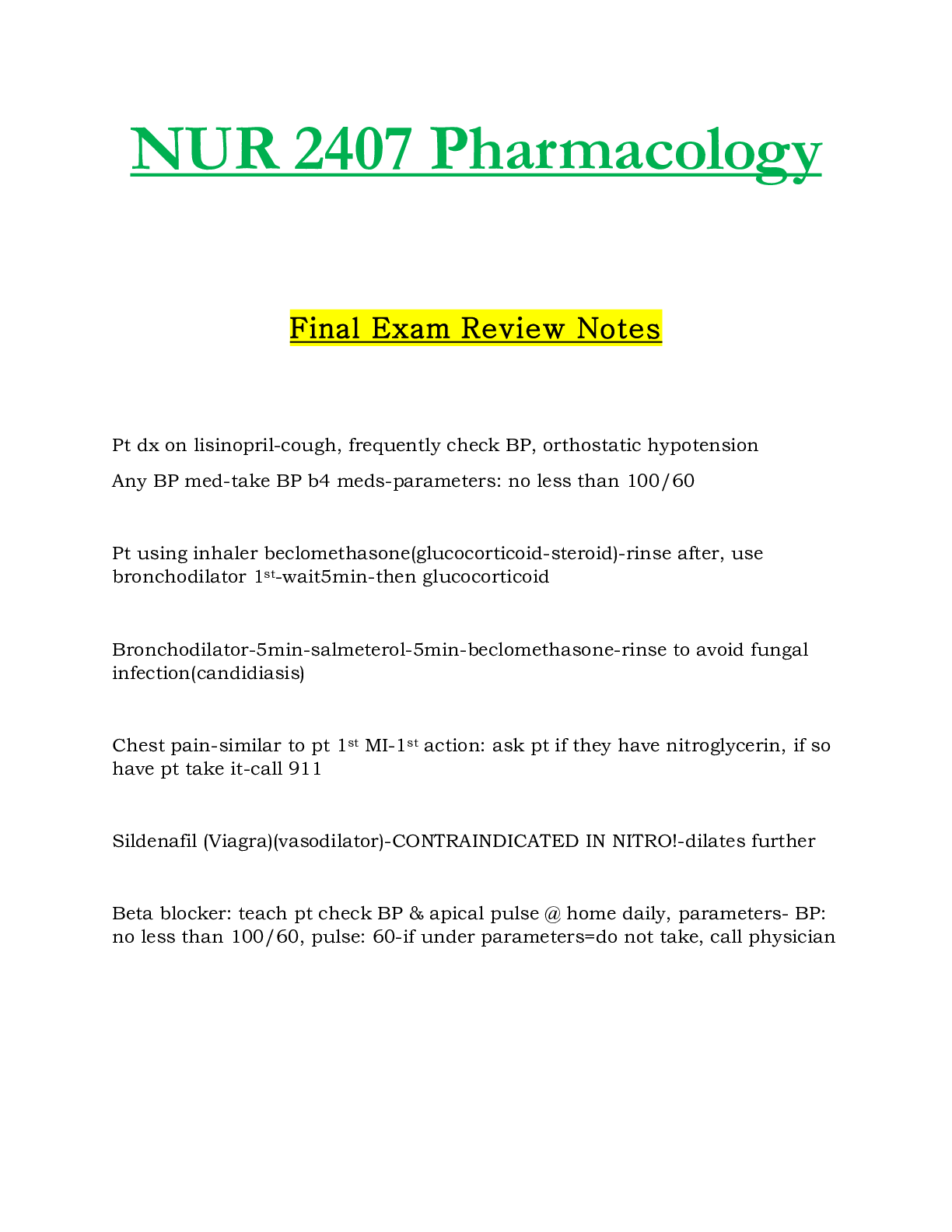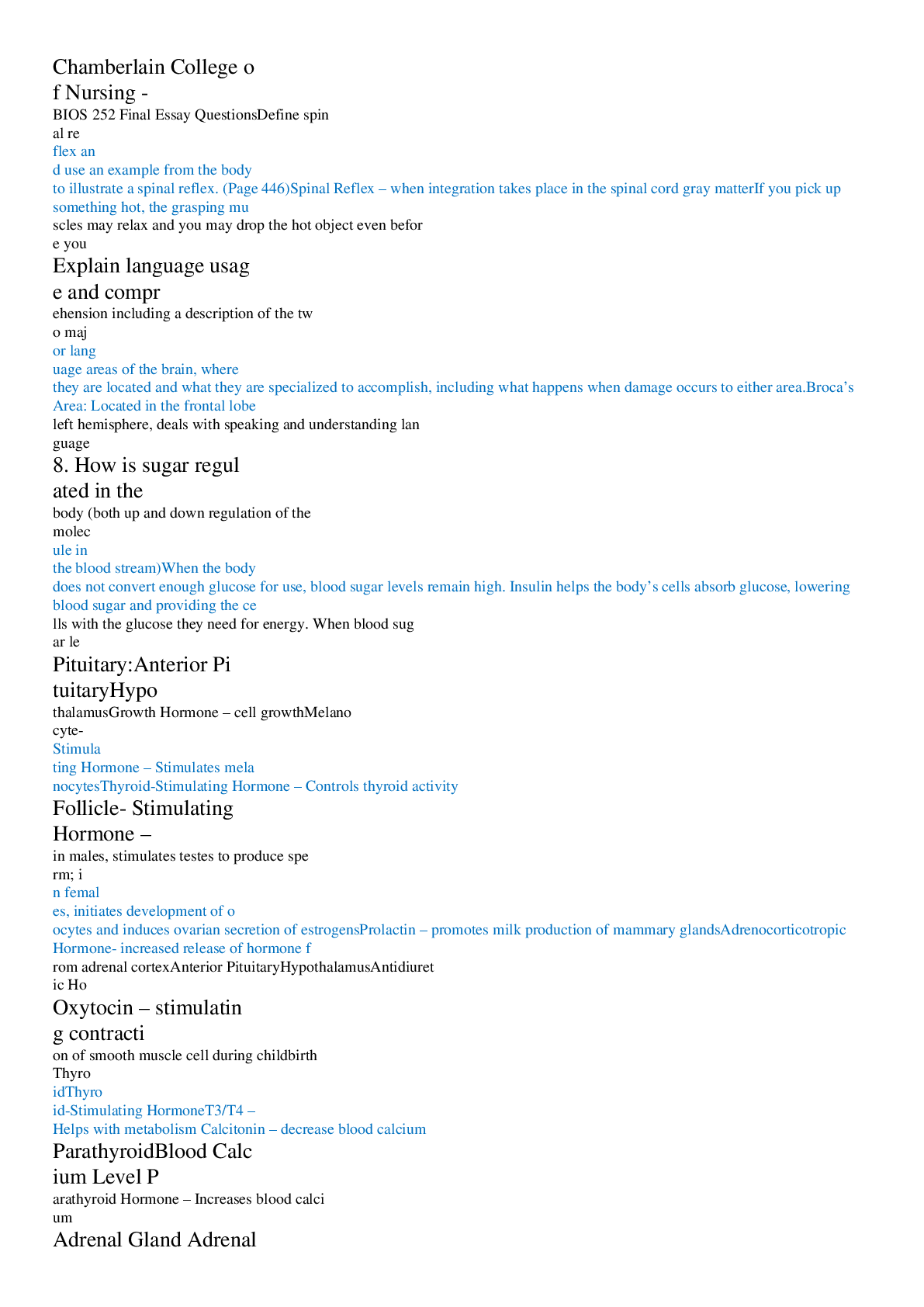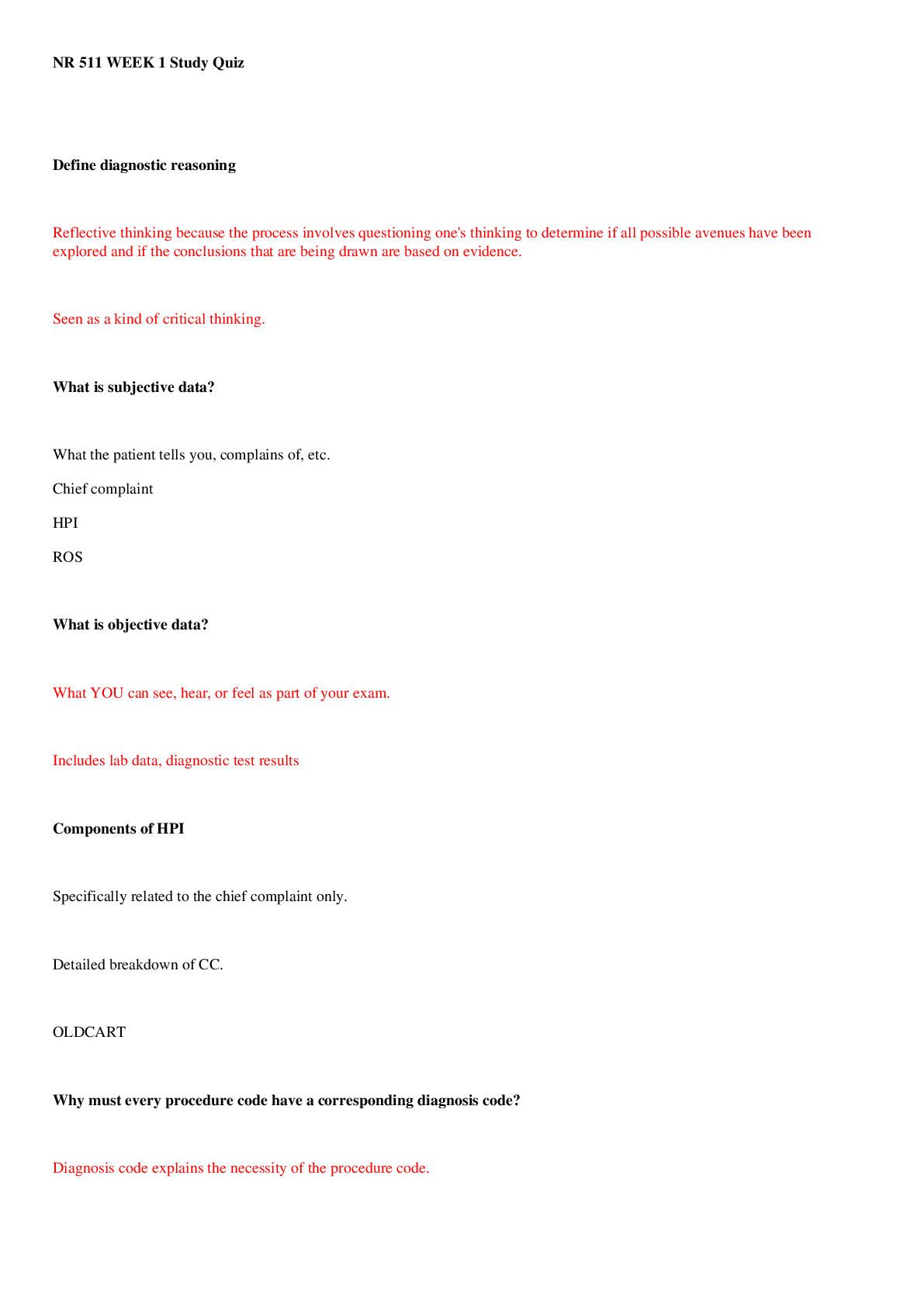*NURSING > EXAM REVIEW > NR 283 / NR283: Pathophysiology Final Exam Review Latest Update Chamberlain College of Nursing (All)
NR 283 / NR283: Pathophysiology Final Exam Review Latest Update Chamberlain College of Nursing
Document Content and Description Below
NR-283 Pathophysiology Final Exam Review 1. What is F.A.S.T - 1. Facial Drooping 2. Arm drifts down (usually only one arm) 3. Speech is Slurred 4. Time to call 911 2. What are the t... ypical consequences of a stroke? - Patient may experience paralysis, sensory loss, language disorders, reflex changes, aphasia, dysphagia 3. What SIADH? - Syndrome of inappropriate antidiuretic hormone is increased levels of the antidiuretic hormone. 4. What endocrine dysfunction is caused by tumor, pulmonary disorder, or surgery meds? - SIADH 5. What endocrine dysfunction causes confusion, thirst, fatigue, muscle twitching, anorexia, nausea and vomiting. - 6. Type of diabetes caused by a decreased level of antidiuretic hormone. - 7. What are the typical symptoms of diabetes insipidus? - 8. Hyperthyroid symptoms - 9. Hypothyroid symptoms - 10. When the bodies receptors are resistant to insulin. Typically found in type 2 diabetics. - 11. When the body isn't making enough insulin. Typically found in type 1 diabetics. - 12. Type I DM - 13. Type I DM Symptoms - 14. Type I DM Diagnostic/Treatment - 15. Type II DM - 16. What is metabolic syndrome - 17. Acute DM emergency - 18. What causes DKA? - 19. Symptoms of DKA - 20. Diabetic Acute Retinopathy - 21. What condition occurs with prolonged exposure to high blood sugar and damage to delicate nerve fibers. - 22. Diabetic Renal Damage - 23. Negative feedback loop - 24. What is the most common cause of alteration to the endocrine system? - 25. The endocrine system - 26. How does TSH and T3/T4 work together? - 27. Insulin - 28. What hormone increases blood calcium levels by stimulating demineralization and increasing absorption of calcium in the digestive tract and kidneys. - 29. Osmosis - 30. Diffusion - 31. Hallmarks of Cancer - 32. Angiogenesis - 33. Local Inflammation - 34. Systemic Inflammation - 35. Degranulation - 36. Chemotaxis - 37. Exudate - 38. Phagocytosis - 39. Purpose of Inflammation - 40. Being over 35yo and trisomy on gene 21 puts and individual at risk for what disorder? - 41. What type of pulmonary disorder is Asthma? - 42. S/S of Asthma - 43. Pathology of Asthma - 44. Erythrocytes - 45. Leukocytes - 46. Platelets - 47. Anemia - 48. Thrombocytopenia - 49. Thrombocythemia - 50. Atherosclerosis - 51. What causes damage to the inner wall of an artery causing fatty deposits and cholesterol and settle? - 52. What type of cell is formed when macrophages come to eat LDL's that have been caught into a damaged portion of an arterial wall and get stuck? - 53. Portal Hypertension - 54. Ascites - 55. What are the two main health risks of Portal hypertension? - 56. Cirrhosis - 57. Enlarged liver, anorexia, nausea, jaundice, edema and ascites are clinical manifestations of what? - 58. Complications of Ascities - 59. Renal Calculi (kidney stones) - 60. A tumor, inflammation, scarring and stenosis accompanied by flank pain, urgency, frequency to urinate, N/V and hematuria is described as what? - 61. Inflammation of urinary epithelium due to bacteria is known as? - 62. What is an infection of the bladder accompanied with groin pain? - 63. What is an infection of the kidneys accompanied with flank pain? - 64. What population is typically asymptomatic to renal infection or obstructions? (may shows signs of confusion) - 65. Osteoporosis - 66. Osteoporosis Pathophysiology - 67. Risk factors for Osteoporosis - 68. Rheumatoid Arthritis - 69. Pathophysiology Rheumatoid Arthritis - 70. Difference between Osteoarthritis & Rheumatoid Arthritis - 71. Acute Pain - 72. Chronic pain - 73. Neuropathic pain - 74. What is the treatment that increases or decreases transmission of pain signals? - 75. What are the chemicals that the nervous system uses to communicate with a brain? - 76. Pain Transduction - 77. What pain pathway signal goes to the central nervous system - 78. Pain pathway how the brain interprets the pain signal - 79. Minimum number of stimuli that it takes for you to perceive pain. This pathway is the same for everyone - 80. The amount of pain the body can handle before you involuntarily remove the stimuli. - 81. The type of pain that transmit from the peripheral nervous system to the central nervous system - 82. When the pain goes from the central nervous system to the peripheral nervous system tell somebody how to react. - 83. Endorphins - 84. What chemical reduces translation of pain. This usually happens after the labor/childbirth - 85. This condition as a result of massive firing of neurons all at the same time. - 86. Why are seizures life-threatening? - 87. What are typical causes of seizures? - 88. Preictal phase (prodromal) - 89. Preictal Phase (Aura) - 90. Ictal Phase (Tonic) - 91. Ictal Phase (Clonic) - 92. Postictal Phase - 93. Ischemic Stroke (Thrombotic) - 94. Ischemic Stroke (Embolic) - 95. Hemorrhagic Stroke - 96. What is the most common cause of an embolic stroke? - [Show More]
Last updated: 2 years ago
Preview 1 out of 10 pages

Buy this document to get the full access instantly
Instant Download Access after purchase
Buy NowInstant download
We Accept:

Reviews( 0 )
$11.00
Can't find what you want? Try our AI powered Search
Document information
Connected school, study & course
About the document
Uploaded On
Nov 13, 2020
Number of pages
10
Written in
Additional information
This document has been written for:
Uploaded
Nov 13, 2020
Downloads
0
Views
119



 JY21.png)









.png)






.png)


